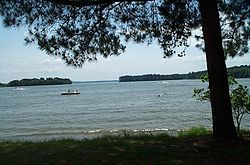Lake Livingston
| Lake Livingston | |
|---|---|
 |
|
| Location | Polk, San Jacinto, Trinity and Walker Counties, Texas |
| Coordinates | 30°44′N 95°09′W / 30.74°N 95.15°WCoordinates: 30°44′N 95°09′W / 30.74°N 95.15°W |
| Type | reservoir |
| Primary inflows | Trinity River |
| Primary outflows | Trinity River |
| Catchment area | 16,616 sq mi (43,040 km2) |
| Basin countries | United States |
| Max. length | 31 mi (50 km) |
| Max. width | 9 mi (14 km) |
| Surface area | 336 km2 (130 sq mi) |
| Average depth | 23 ft (7.0 m) |
| Max. depth | 90 ft (27 m) |
| Water volume | 1,750,000 acre·ft (2.16 km3) |
| Shore length1 | over 450 mi (720 km) |
| Surface elevation | 131 ft (40 m) |
| Islands |
Alligator Island Pine Island |
| Settlements |
Trinity Onalaska Point Blank Riverside |
| References | |
| 1 Shore length is not a well-defined measure. | |
Lake Livingston is a reservoir located in the East Texas Piney Woods. Lake Livingston was built, and is owned and operated, by the Trinity River Authority of Texas (TRA) under contract with the City of Houston for water-supply purposes. The lake is the second-largest lake located wholly within the state of Texas (only the Sam Rayburn Reservoir is larger). The Livingston Dam, constructed across the Trinity River approximately 7 miles (11 km) southwest of the city of Livingston is 2.5 miles (4 km) in length and has an average depth of 55 feet (17 m).
The lake construction was paid for by the sale of revenue bonds that were to be redeemed with income derived from the sale of water. The dam construction began in 1966 and was completed in 1969, by Forrest and Cotton, Incorporated. The cost to build the earthen dam was US$83,996,957.
Water stored in the lake is used to supply industrial, municipal and agricultural needs in the lower Trinity River Basin and the Houston/Galveston metropolitan area. Its significance in the face of the extraordinary growth experienced by this region of the Upper Texas Gulf Coast is tremendous. A wide range of public and commercial recreation facilities including full service marinas, camping and motel accommodations are located along the shoreline. The City of Houston owns two-thirds of the water rights of the lake, with the other 1/3 remaining under control of the TRA.
The earthfill dam has a concrete spillway and was designed by Brown and Root, Incorporated (now KBR, Inc). The dam has a spillway crest elevation of 99 feet (30 m) above mean sea level. The average base width of the Dam's earthen embankment is 310 feet (94 m) wide. The spillway is designed and constructed to pass flows of three times the maximum-recorded flow of the river at this site.
...
Wikipedia
